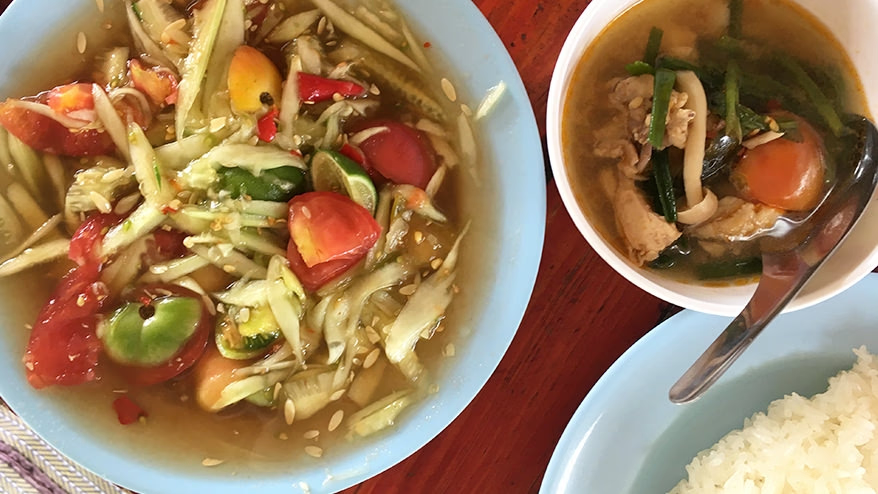Hello! This is Machiyama from Monosus Thailand.
Living in Thailand, there are many things I feel are different from Japan. In this series, I will introduce the things I feel because I live in Thailand, in the form of my own thoughts on Thai things. In the second installment, I will focus on the food situation in Thailand!
Now that I think about it, I didn't like Thai food before I came to Thailand. It was sour, spicy, and had a strong smell, so it wasn't the kind of food I actively wanted to eat. But that's no longer the case. I've gotten used to the sour and spicy flavors, and can now properly appreciate the deliciousness of the spicy taste. Also, even though it's called Thai food, there are many different types of cuisine. At the time, I didn't realize how many types there were, so I tried a few dishes and decided that I didn't like it in general, I'm sorry. However, I would like to start by touching on the differences in taste and smell between Thai and Japanese people, which I'm sure will be useful for Japanese tourists who are visiting Thailand.
Pungent taste and smell
Even if you say "Don't make it spicy," it's still spicy
Thai people can handle spicy food very well. I've never really liked spicy food, so when I ordered food, I would forget to ask for it not to be too spicy, and my lips would hurt so much that I would scream in pain. Even when I said "mai pet" (don't make it spicy), the spiciness often didn't seem to be toned down...lol. In other words, what is not spicy for Thai people is still too spicy for me. In those cases, I can only feel at ease if I ask "mai ao pet" ( don't put anything spicy in). However, I feel that recently many restaurants are making their dishes less spicy for tourists. Local restaurants tend to serve them at a higher level of spiciness. Gapao rice, which is often eaten in Japan, is actually quite spicy at local restaurants.
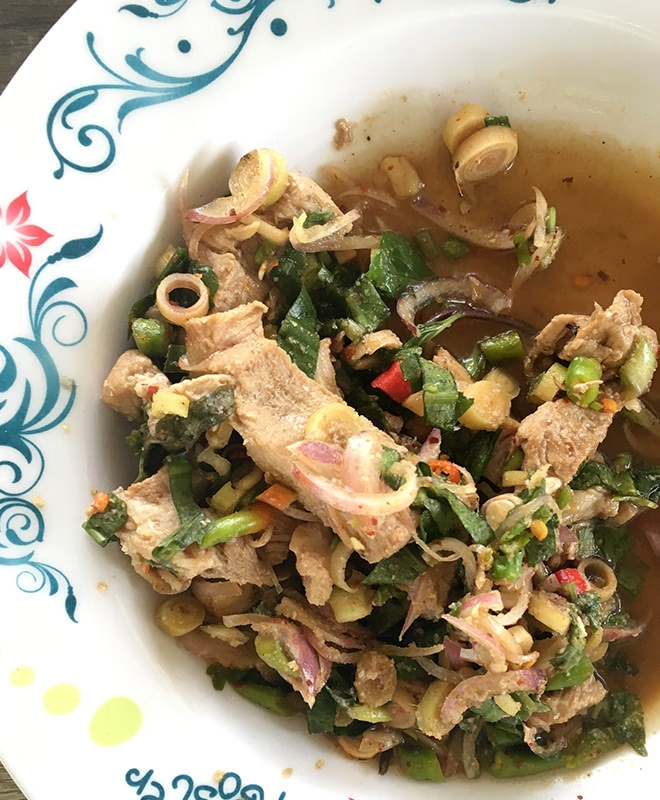
Nam Tok: Spicy salad steak from the Isan region. An example of a spicy dish. I tried it for the first time recently and it made my lips tingle.
Even if I say "Don't make it sweet," it's still sweet
Thai people generally have a sweet tooth. I often hear stories of Japanese tourists drinking Thai iced tea and choking because it's too sweet. Again, the coffee and black tea sold at local food stalls are generally quite sweet. They sometimes contain condensed milk. Even bottled green tea made in Japan is mainly sold in a sweet version made for Thai tastes, so you need to be careful even at convenience stores. Japanese people who don't have the idea that tea should be sweet often end up experiencing culture shock when they buy tea at a convenience store while traveling without looking carefully at the label.
Smelly vs. nice smell
When walking around the city of Thailand, you often smell a strong, stinky smell. I thought I'd get used to it if I lived there, but I still can't get used to it (sorry!). Now I've pretty much figured out which roads stink, so I hold my breath when I pass by. In my personal opinion, the main culprit when it comes to food smells is som tam. There seem to be different types of som tam, some of which are particularly strong... If you click here for more details, you'll get a full sense of the smell. There is a Japanese staff member at Monosus Thailand who loves this, and it's a pain that we're sitting next to each other.
However, recently, when the staff member sitting next to me started eating som tam as usual and I commented that it smelled bad, it turned out that the Thai staff member didn't even notice the smell; in fact, he thought it smelled good and made him hungry!
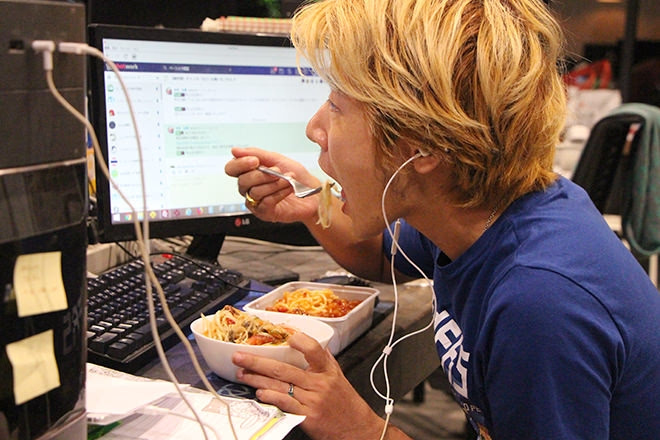
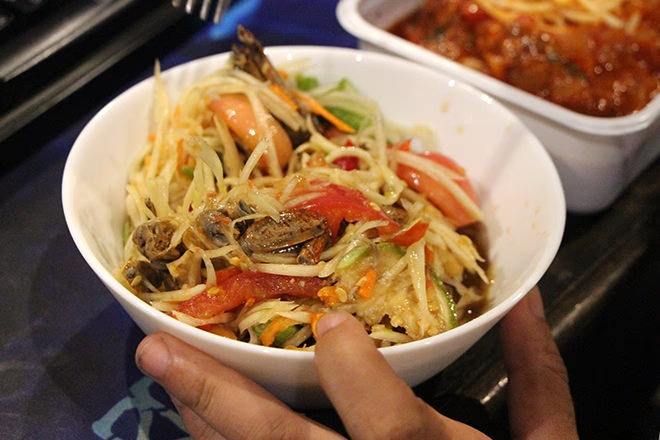 Som Tam Korat: A specialty of Korat province. It is Som Tam Thai + salted crab + Para (a seasoning made from fermented fish).
Som Tam Korat: A specialty of Korat province. It is Som Tam Thai + salted crab + Para (a seasoning made from fermented fish).
I see... that's right. It's like natto, which Japanese people eat from a young age. It was an interesting experience that made me feel a cultural difference that had been ingrained in me for the first time in a long time. (Of course, I think it depends on the person, even among Japanese people!)
The way you drink your drink is strange
Wonders Part 1
A straw in a plastic bottle?
In Thailand, when you buy a plastic bottle, it almost always comes with a straw. This was the first time I drank in this style since coming to Thailand. The good thing about plastic bottles is that you can carry them around even if you don't finish it at once, but the straws are all different lengths, so if you put a straw in the bottle, it can fall out and become impossible to remove, or you can't close the lid. In the end, I've decided to tell them from the start that I don't need one.
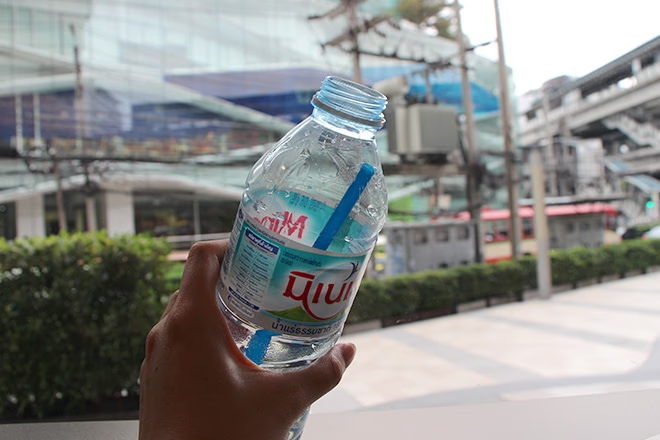
The straw fell inside and I can't get it out...
Wonders Part 2
Straw extending from the bag
Part 1 wasn't that surprising. However, part 2 was quite a shock. The lady was drinking something with a straw sticking out of a bag in her mouth. I thought there was a cup inside the bag, but there wasn't. She actually poured the liquid directly into the bag, inserted the straw, and sipped. This surprised me. I'd never thought of it like that! It seems that you can get it this way at local general stores.
Food stall appearance rate
In Thailand, scenes similar to those seen at street stalls at Japanese festivals are spread all over the place every day. For Thai people, street stalls are not a special occasion but a common one. Street stalls are found all over the city and are a part of life, and it seems that the general style is to buy food from a street stall and take it home to eat at home. This means that there is a wide variety of street stalls and the types of items they sell. From here, we would like to introduce the street stalls (sales carts, etc.) that can be seen in Thailand, including the frequency of items sold.
Mobile greengrocer
Frequency of occurrence ★★★★
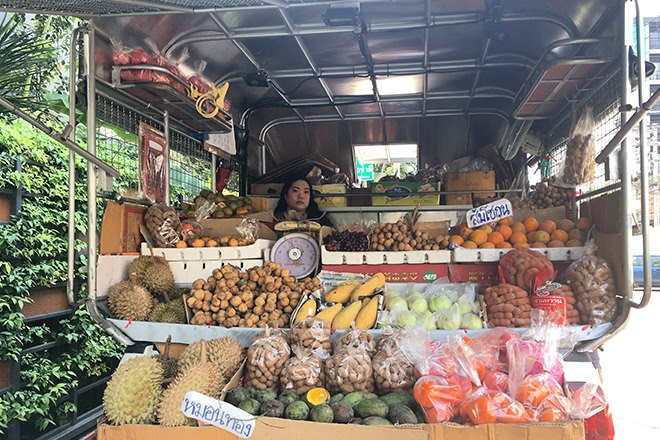
The bed of the car is piled high with vegetables and fruits. It's a mobile greengrocer, and they appear quite often. They probably spend a lot of their day here, and many of the cars even have a TV loaded up, giving them a lived-in feel. The car in this photo is pretty clean, but there are a lot of cluttered cars with as many products as they can be tied to the wire mesh on both sides.
Grilled food + Somtam
Frequency of occurrence ★★★★★
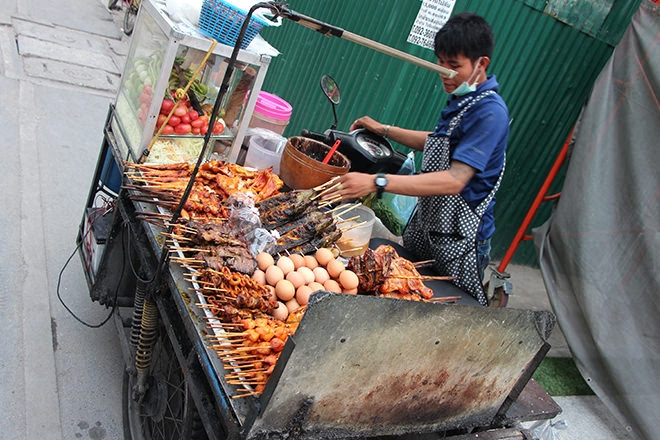
This is a stall that sells meat, fish, fish cakes, eggs, squid, and som tam. They are usually found under the stairs leading to the ticket gates of train stations. It is usually very busy in the evening, so many people buy it to take home as a side dish for dinner.
A store that suddenly appears on the sidewalk
Frequency of occurrence ★★★★
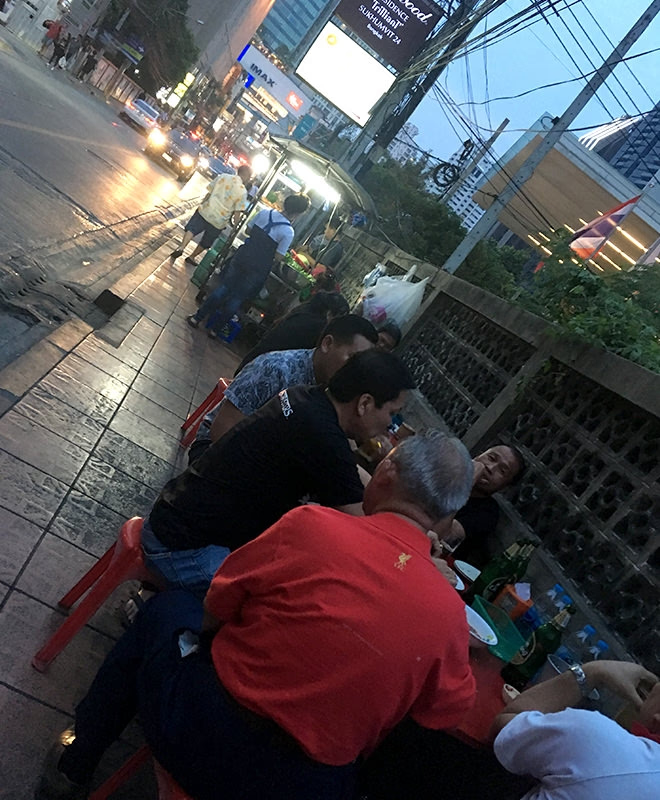
As it starts to get dark, shops start appearing on the sidewalk. Tables and chairs are set up, and local people are chatting away while drinking. Sidewalks in Thailand are narrow to begin with, so they can be quite a nuisance to passersby, but the atmosphere here is exotic and fun.
However, the way they wash dishes is quite careless, so some people might find it annoying if they see them doing so...of course, it depends on the restaurant.
Cart selling fruit
Frequency of occurrence ★★★★★
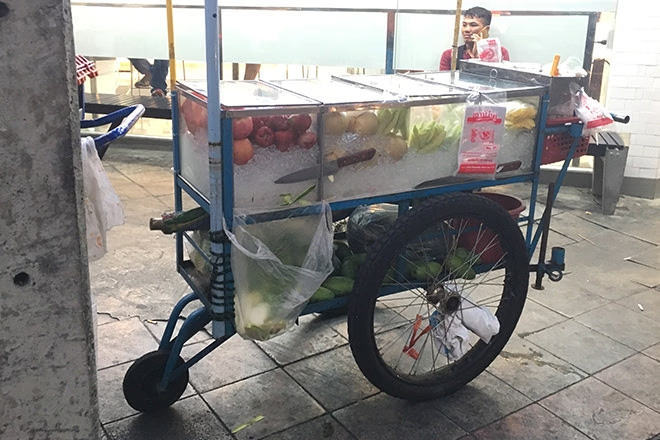
This is a cart that sells fruits cut into easy-to-eat pieces. The lineup includes pineapple, watermelon, apples, unripe mangoes, coconuts, etc. I often buy pineapple. I wish they did the same in Japan. In Japan, there seem to be strict rules on hygiene and outdoor food stalls. In Thailand, there don't seem to be such strict rules.
Cart for selling ○○
Frequency of occurrence ★★★
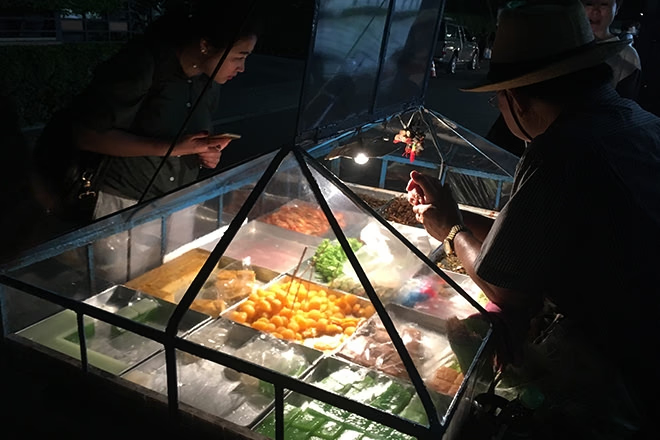
They sell insects along with sweets. Crickets, caterpillars, wasps, giant water bugs, etc. Giant water bugs are apparently expensive.
Of the many outdoor stalls, the one that I think is unique to Thailand is "insects." Nowadays, you can tell what they are selling by looking at the shape of the cart even from a distance, but the insect carts are covered in clear plastic. And since they are often seen in the evening and at night, they are lit up with warm-colored lights. I've never really stared at them up close because I find them disgusting, but since many people buy them regularly, they may be something that is eaten on a daily basis in ordinary households. I haven't been brave enough to try them yet. In the photo, they are the ones in the back right.
Squid Seller Bicycle
Frequency of occurrence ★
Another strange thing that I think you would never see in Japan is a man who comes to sell "small flying squids" with clothespins on the back of his bicycle. I personally don't see these flying squids very often (they can move around easily by bicycle, so they don't seem to stay in a fixed spot for long), so when I do see them, I feel lucky.
Cotton candy
Frequency of occurrence ★
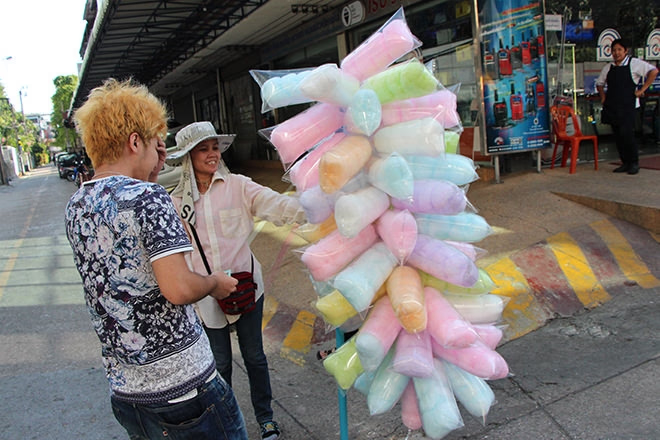
On the way back from lunch, I bumped into a girl selling cotton candy! It's not easy to find her here either, so if you do, you're lucky. The colors are cute and colorful. Cotton candy is 20 baht.
It's okay to be relaxed
What did you think? This time we focused on food.
In Japan, regulations on hygiene and the use of public places are strict, for better or worse, so it is rare to see scenes like in Thailand where people's daily lives spill out into public places. Personally, I think it would be nice if there was a little more laxity like this in urban areas in Japan. I hope that I have been able to give you at least a little idea of what daily life is like in Thailand, especially when it comes to food.
We hope to continue introducing Thai things in a variety of genres in the future!
